Psychosocial Impacts of Type 2 Diabetes Mellitus: A Case Study
VerifiedAdded on 2023/04/23
|17
|4564
|406
AI Summary
This case study focuses on the psychosocial impacts of Type 2 Diabetes Mellitus (T2DM) on the patient and their family. It highlights the importance of a multi-disciplinary team (MDT) in formulating an effective plan of care and support for the patient. The document type is a case study and the type of assignment is a nursing assignment.
Contribute Materials
Your contribution can guide someone’s learning journey. Share your
documents today.
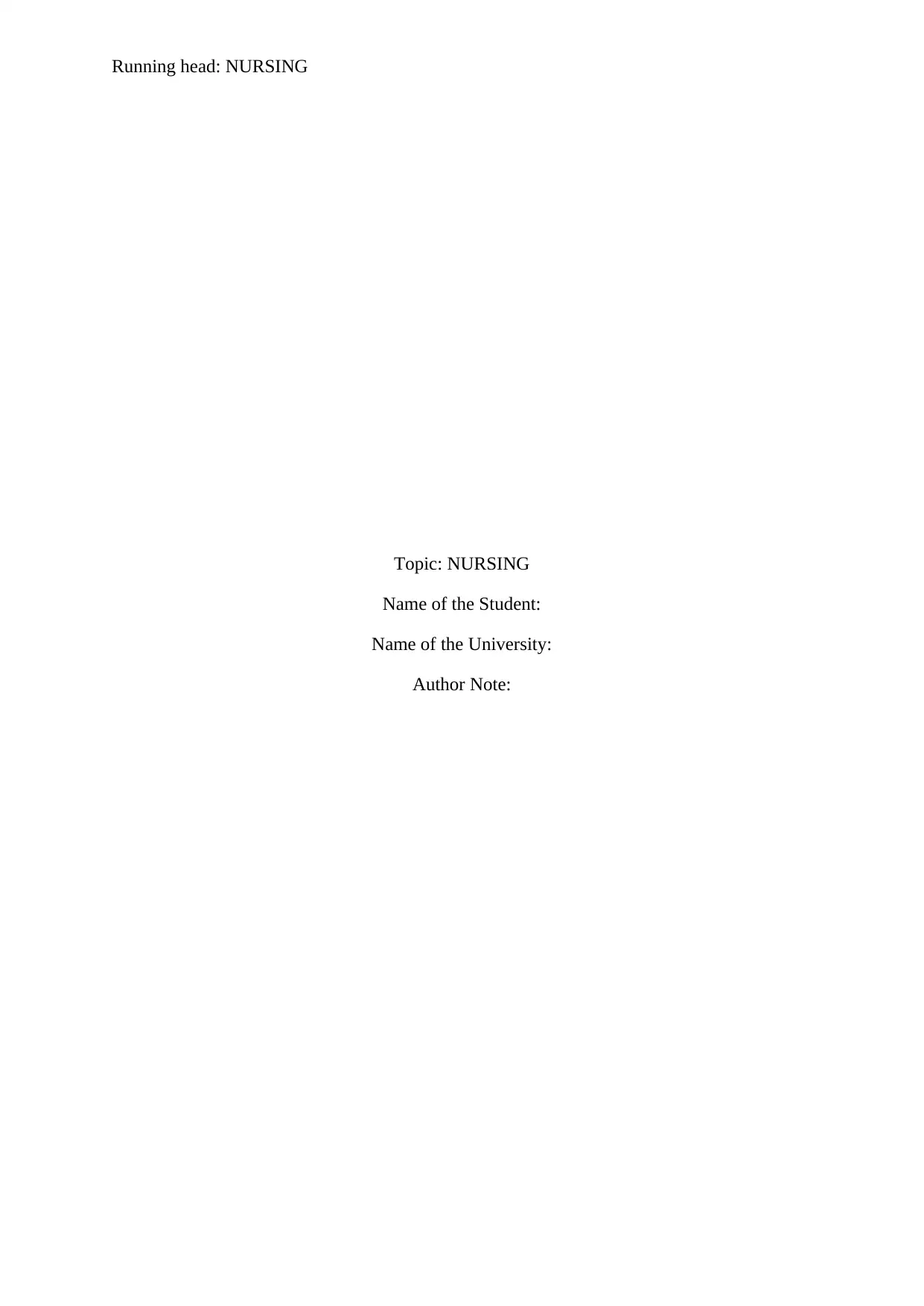
Running head: NURSING
Topic: NURSING
Name of the Student:
Name of the University:
Author Note:
Topic: NURSING
Name of the Student:
Name of the University:
Author Note:
Secure Best Marks with AI Grader
Need help grading? Try our AI Grader for instant feedback on your assignments.
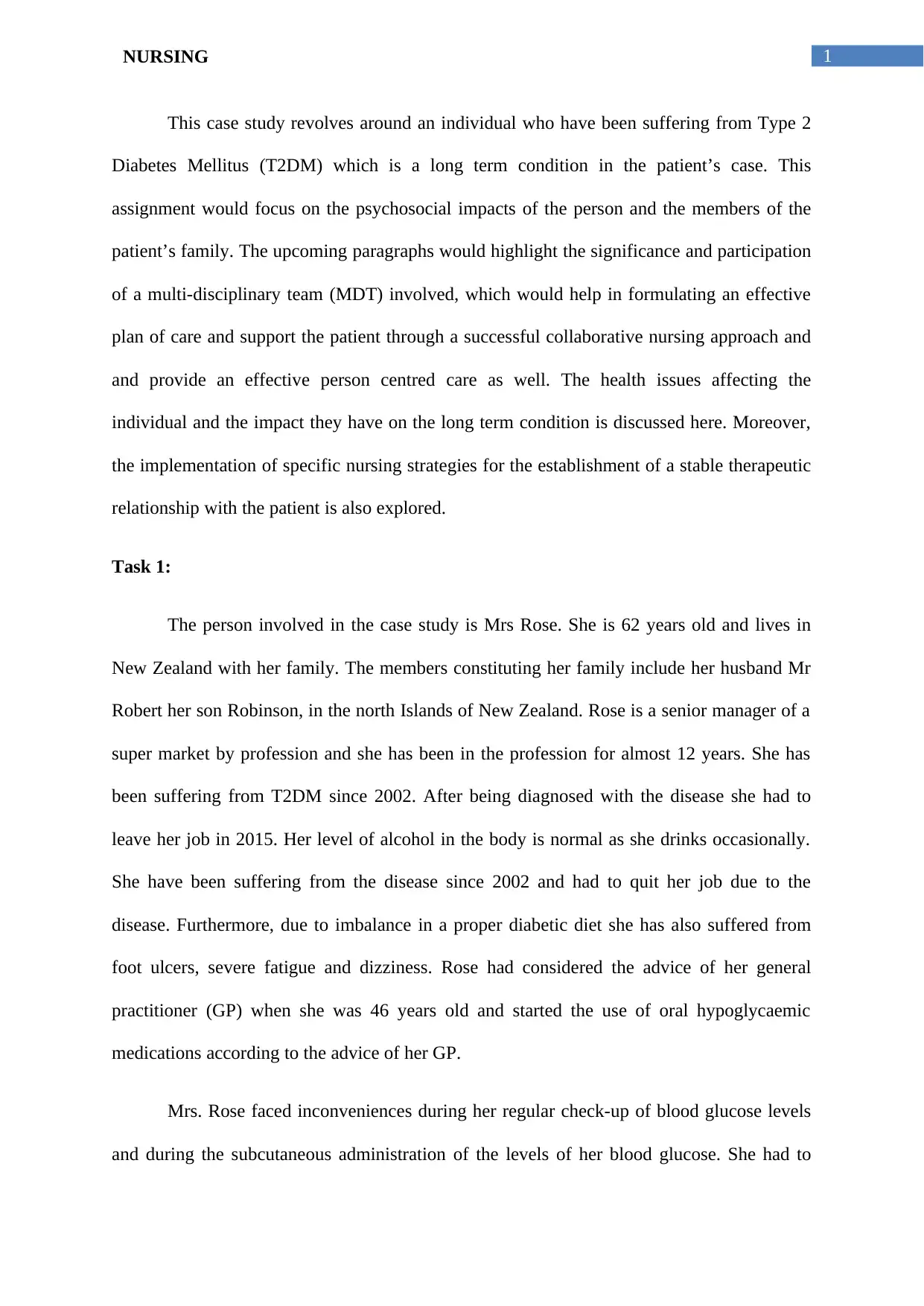
1NURSING
This case study revolves around an individual who have been suffering from Type 2
Diabetes Mellitus (T2DM) which is a long term condition in the patient’s case. This
assignment would focus on the psychosocial impacts of the person and the members of the
patient’s family. The upcoming paragraphs would highlight the significance and participation
of a multi-disciplinary team (MDT) involved, which would help in formulating an effective
plan of care and support the patient through a successful collaborative nursing approach and
and provide an effective person centred care as well. The health issues affecting the
individual and the impact they have on the long term condition is discussed here. Moreover,
the implementation of specific nursing strategies for the establishment of a stable therapeutic
relationship with the patient is also explored.
Task 1:
The person involved in the case study is Mrs Rose. She is 62 years old and lives in
New Zealand with her family. The members constituting her family include her husband Mr
Robert her son Robinson, in the north Islands of New Zealand. Rose is a senior manager of a
super market by profession and she has been in the profession for almost 12 years. She has
been suffering from T2DM since 2002. After being diagnosed with the disease she had to
leave her job in 2015. Her level of alcohol in the body is normal as she drinks occasionally.
She have been suffering from the disease since 2002 and had to quit her job due to the
disease. Furthermore, due to imbalance in a proper diabetic diet she has also suffered from
foot ulcers, severe fatigue and dizziness. Rose had considered the advice of her general
practitioner (GP) when she was 46 years old and started the use of oral hypoglycaemic
medications according to the advice of her GP.
Mrs. Rose faced inconveniences during her regular check-up of blood glucose levels
and during the subcutaneous administration of the levels of her blood glucose. She had to
This case study revolves around an individual who have been suffering from Type 2
Diabetes Mellitus (T2DM) which is a long term condition in the patient’s case. This
assignment would focus on the psychosocial impacts of the person and the members of the
patient’s family. The upcoming paragraphs would highlight the significance and participation
of a multi-disciplinary team (MDT) involved, which would help in formulating an effective
plan of care and support the patient through a successful collaborative nursing approach and
and provide an effective person centred care as well. The health issues affecting the
individual and the impact they have on the long term condition is discussed here. Moreover,
the implementation of specific nursing strategies for the establishment of a stable therapeutic
relationship with the patient is also explored.
Task 1:
The person involved in the case study is Mrs Rose. She is 62 years old and lives in
New Zealand with her family. The members constituting her family include her husband Mr
Robert her son Robinson, in the north Islands of New Zealand. Rose is a senior manager of a
super market by profession and she has been in the profession for almost 12 years. She has
been suffering from T2DM since 2002. After being diagnosed with the disease she had to
leave her job in 2015. Her level of alcohol in the body is normal as she drinks occasionally.
She have been suffering from the disease since 2002 and had to quit her job due to the
disease. Furthermore, due to imbalance in a proper diabetic diet she has also suffered from
foot ulcers, severe fatigue and dizziness. Rose had considered the advice of her general
practitioner (GP) when she was 46 years old and started the use of oral hypoglycaemic
medications according to the advice of her GP.
Mrs. Rose faced inconveniences during her regular check-up of blood glucose levels
and during the subcutaneous administration of the levels of her blood glucose. She had to
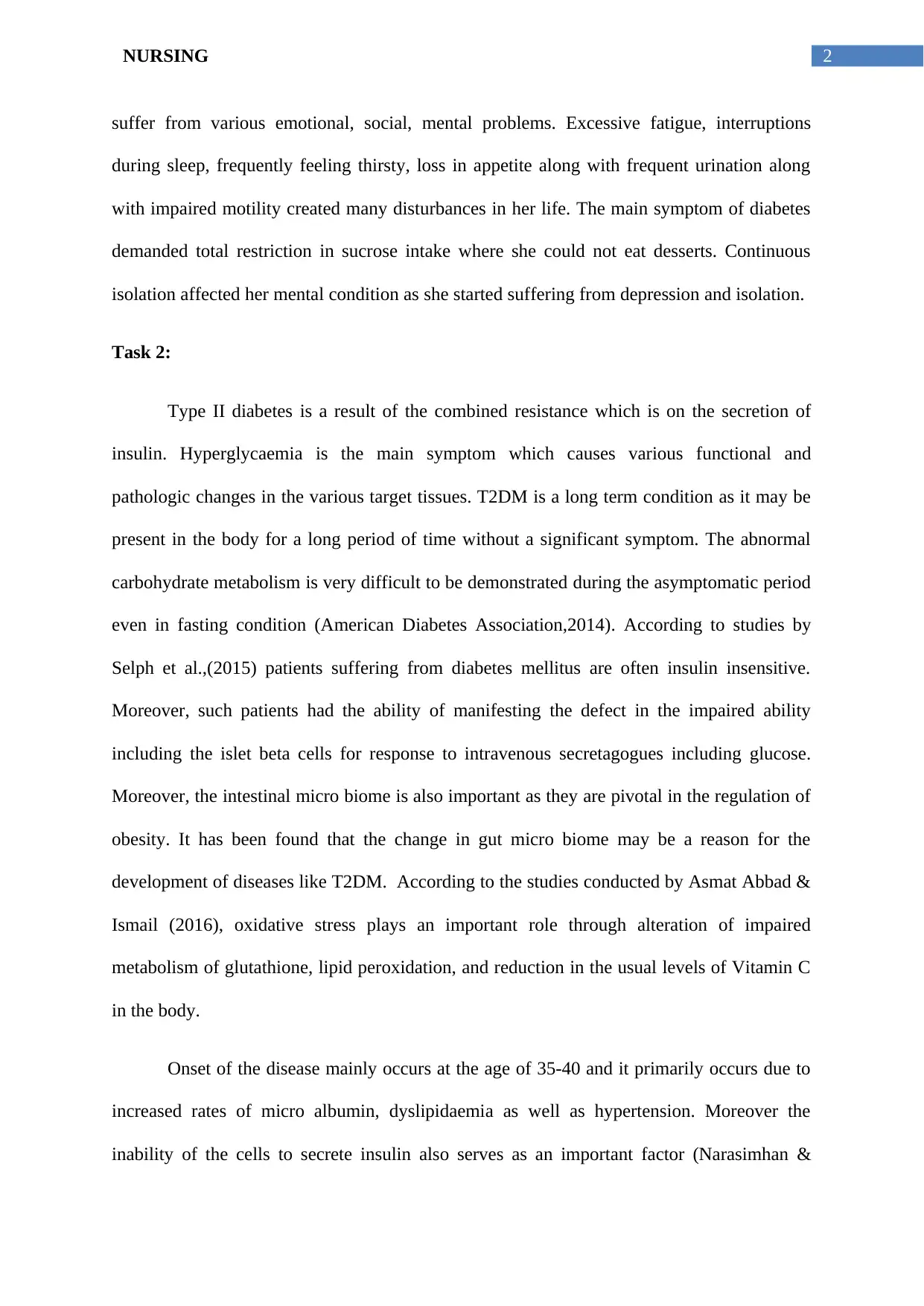
2NURSING
suffer from various emotional, social, mental problems. Excessive fatigue, interruptions
during sleep, frequently feeling thirsty, loss in appetite along with frequent urination along
with impaired motility created many disturbances in her life. The main symptom of diabetes
demanded total restriction in sucrose intake where she could not eat desserts. Continuous
isolation affected her mental condition as she started suffering from depression and isolation.
Task 2:
Type II diabetes is a result of the combined resistance which is on the secretion of
insulin. Hyperglycaemia is the main symptom which causes various functional and
pathologic changes in the various target tissues. T2DM is a long term condition as it may be
present in the body for a long period of time without a significant symptom. The abnormal
carbohydrate metabolism is very difficult to be demonstrated during the asymptomatic period
even in fasting condition (American Diabetes Association,2014). According to studies by
Selph et al.,(2015) patients suffering from diabetes mellitus are often insulin insensitive.
Moreover, such patients had the ability of manifesting the defect in the impaired ability
including the islet beta cells for response to intravenous secretagogues including glucose.
Moreover, the intestinal micro biome is also important as they are pivotal in the regulation of
obesity. It has been found that the change in gut micro biome may be a reason for the
development of diseases like T2DM. According to the studies conducted by Asmat Abbad &
Ismail (2016), oxidative stress plays an important role through alteration of impaired
metabolism of glutathione, lipid peroxidation, and reduction in the usual levels of Vitamin C
in the body.
Onset of the disease mainly occurs at the age of 35-40 and it primarily occurs due to
increased rates of micro albumin, dyslipidaemia as well as hypertension. Moreover the
inability of the cells to secrete insulin also serves as an important factor (Narasimhan &
suffer from various emotional, social, mental problems. Excessive fatigue, interruptions
during sleep, frequently feeling thirsty, loss in appetite along with frequent urination along
with impaired motility created many disturbances in her life. The main symptom of diabetes
demanded total restriction in sucrose intake where she could not eat desserts. Continuous
isolation affected her mental condition as she started suffering from depression and isolation.
Task 2:
Type II diabetes is a result of the combined resistance which is on the secretion of
insulin. Hyperglycaemia is the main symptom which causes various functional and
pathologic changes in the various target tissues. T2DM is a long term condition as it may be
present in the body for a long period of time without a significant symptom. The abnormal
carbohydrate metabolism is very difficult to be demonstrated during the asymptomatic period
even in fasting condition (American Diabetes Association,2014). According to studies by
Selph et al.,(2015) patients suffering from diabetes mellitus are often insulin insensitive.
Moreover, such patients had the ability of manifesting the defect in the impaired ability
including the islet beta cells for response to intravenous secretagogues including glucose.
Moreover, the intestinal micro biome is also important as they are pivotal in the regulation of
obesity. It has been found that the change in gut micro biome may be a reason for the
development of diseases like T2DM. According to the studies conducted by Asmat Abbad &
Ismail (2016), oxidative stress plays an important role through alteration of impaired
metabolism of glutathione, lipid peroxidation, and reduction in the usual levels of Vitamin C
in the body.
Onset of the disease mainly occurs at the age of 35-40 and it primarily occurs due to
increased rates of micro albumin, dyslipidaemia as well as hypertension. Moreover the
inability of the cells to secrete insulin also serves as an important factor (Narasimhan &
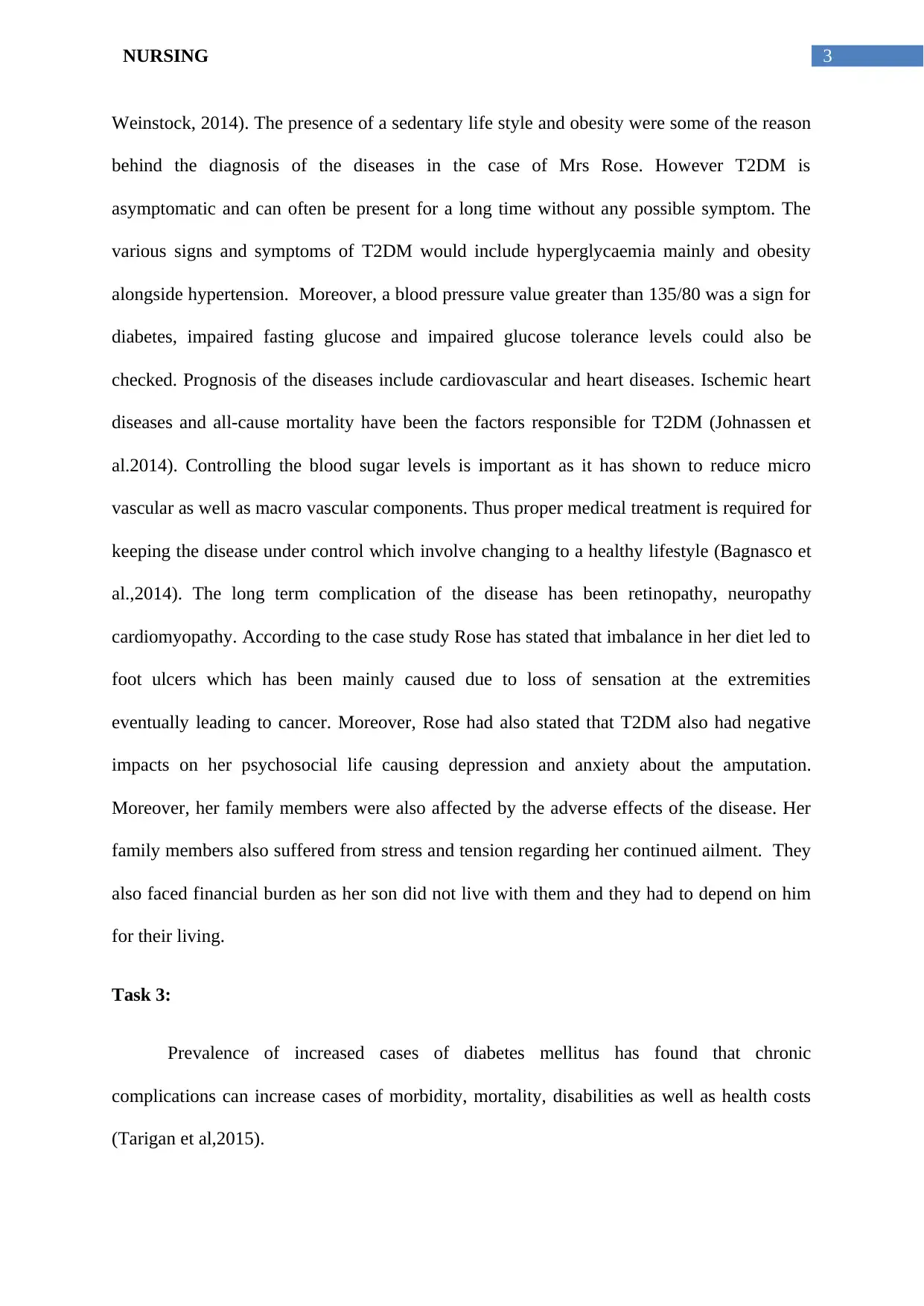
3NURSING
Weinstock, 2014). The presence of a sedentary life style and obesity were some of the reason
behind the diagnosis of the diseases in the case of Mrs Rose. However T2DM is
asymptomatic and can often be present for a long time without any possible symptom. The
various signs and symptoms of T2DM would include hyperglycaemia mainly and obesity
alongside hypertension. Moreover, a blood pressure value greater than 135/80 was a sign for
diabetes, impaired fasting glucose and impaired glucose tolerance levels could also be
checked. Prognosis of the diseases include cardiovascular and heart diseases. Ischemic heart
diseases and all-cause mortality have been the factors responsible for T2DM (Johnassen et
al.2014). Controlling the blood sugar levels is important as it has shown to reduce micro
vascular as well as macro vascular components. Thus proper medical treatment is required for
keeping the disease under control which involve changing to a healthy lifestyle (Bagnasco et
al.,2014). The long term complication of the disease has been retinopathy, neuropathy
cardiomyopathy. According to the case study Rose has stated that imbalance in her diet led to
foot ulcers which has been mainly caused due to loss of sensation at the extremities
eventually leading to cancer. Moreover, Rose had also stated that T2DM also had negative
impacts on her psychosocial life causing depression and anxiety about the amputation.
Moreover, her family members were also affected by the adverse effects of the disease. Her
family members also suffered from stress and tension regarding her continued ailment. They
also faced financial burden as her son did not live with them and they had to depend on him
for their living.
Task 3:
Prevalence of increased cases of diabetes mellitus has found that chronic
complications can increase cases of morbidity, mortality, disabilities as well as health costs
(Tarigan et al,2015).
Weinstock, 2014). The presence of a sedentary life style and obesity were some of the reason
behind the diagnosis of the diseases in the case of Mrs Rose. However T2DM is
asymptomatic and can often be present for a long time without any possible symptom. The
various signs and symptoms of T2DM would include hyperglycaemia mainly and obesity
alongside hypertension. Moreover, a blood pressure value greater than 135/80 was a sign for
diabetes, impaired fasting glucose and impaired glucose tolerance levels could also be
checked. Prognosis of the diseases include cardiovascular and heart diseases. Ischemic heart
diseases and all-cause mortality have been the factors responsible for T2DM (Johnassen et
al.2014). Controlling the blood sugar levels is important as it has shown to reduce micro
vascular as well as macro vascular components. Thus proper medical treatment is required for
keeping the disease under control which involve changing to a healthy lifestyle (Bagnasco et
al.,2014). The long term complication of the disease has been retinopathy, neuropathy
cardiomyopathy. According to the case study Rose has stated that imbalance in her diet led to
foot ulcers which has been mainly caused due to loss of sensation at the extremities
eventually leading to cancer. Moreover, Rose had also stated that T2DM also had negative
impacts on her psychosocial life causing depression and anxiety about the amputation.
Moreover, her family members were also affected by the adverse effects of the disease. Her
family members also suffered from stress and tension regarding her continued ailment. They
also faced financial burden as her son did not live with them and they had to depend on him
for their living.
Task 3:
Prevalence of increased cases of diabetes mellitus has found that chronic
complications can increase cases of morbidity, mortality, disabilities as well as health costs
(Tarigan et al,2015).
Secure Best Marks with AI Grader
Need help grading? Try our AI Grader for instant feedback on your assignments.
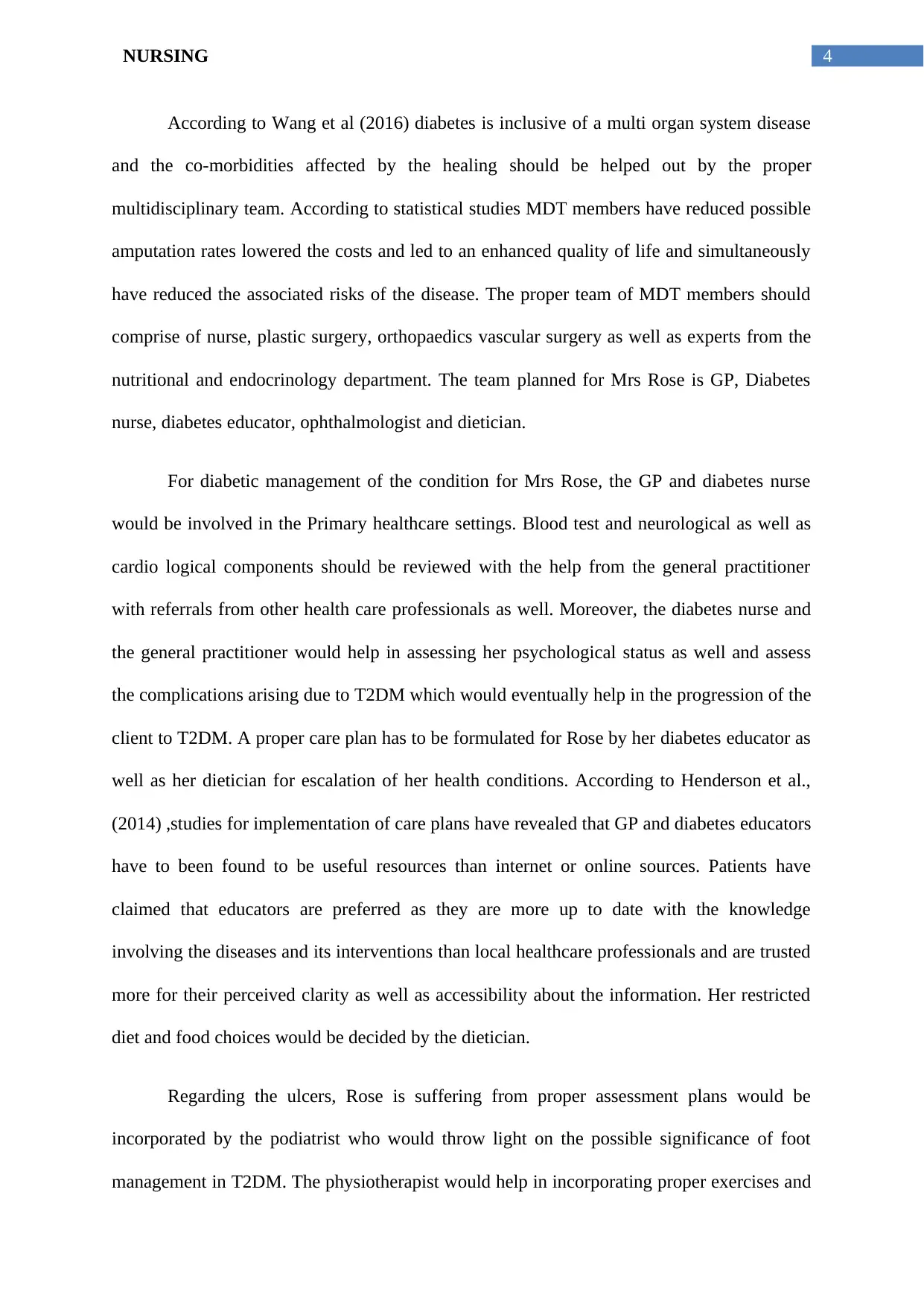
4NURSING
According to Wang et al (2016) diabetes is inclusive of a multi organ system disease
and the co-morbidities affected by the healing should be helped out by the proper
multidisciplinary team. According to statistical studies MDT members have reduced possible
amputation rates lowered the costs and led to an enhanced quality of life and simultaneously
have reduced the associated risks of the disease. The proper team of MDT members should
comprise of nurse, plastic surgery, orthopaedics vascular surgery as well as experts from the
nutritional and endocrinology department. The team planned for Mrs Rose is GP, Diabetes
nurse, diabetes educator, ophthalmologist and dietician.
For diabetic management of the condition for Mrs Rose, the GP and diabetes nurse
would be involved in the Primary healthcare settings. Blood test and neurological as well as
cardio logical components should be reviewed with the help from the general practitioner
with referrals from other health care professionals as well. Moreover, the diabetes nurse and
the general practitioner would help in assessing her psychological status as well and assess
the complications arising due to T2DM which would eventually help in the progression of the
client to T2DM. A proper care plan has to be formulated for Rose by her diabetes educator as
well as her dietician for escalation of her health conditions. According to Henderson et al.,
(2014) ,studies for implementation of care plans have revealed that GP and diabetes educators
have to been found to be useful resources than internet or online sources. Patients have
claimed that educators are preferred as they are more up to date with the knowledge
involving the diseases and its interventions than local healthcare professionals and are trusted
more for their perceived clarity as well as accessibility about the information. Her restricted
diet and food choices would be decided by the dietician.
Regarding the ulcers, Rose is suffering from proper assessment plans would be
incorporated by the podiatrist who would throw light on the possible significance of foot
management in T2DM. The physiotherapist would help in incorporating proper exercises and
According to Wang et al (2016) diabetes is inclusive of a multi organ system disease
and the co-morbidities affected by the healing should be helped out by the proper
multidisciplinary team. According to statistical studies MDT members have reduced possible
amputation rates lowered the costs and led to an enhanced quality of life and simultaneously
have reduced the associated risks of the disease. The proper team of MDT members should
comprise of nurse, plastic surgery, orthopaedics vascular surgery as well as experts from the
nutritional and endocrinology department. The team planned for Mrs Rose is GP, Diabetes
nurse, diabetes educator, ophthalmologist and dietician.
For diabetic management of the condition for Mrs Rose, the GP and diabetes nurse
would be involved in the Primary healthcare settings. Blood test and neurological as well as
cardio logical components should be reviewed with the help from the general practitioner
with referrals from other health care professionals as well. Moreover, the diabetes nurse and
the general practitioner would help in assessing her psychological status as well and assess
the complications arising due to T2DM which would eventually help in the progression of the
client to T2DM. A proper care plan has to be formulated for Rose by her diabetes educator as
well as her dietician for escalation of her health conditions. According to Henderson et al.,
(2014) ,studies for implementation of care plans have revealed that GP and diabetes educators
have to been found to be useful resources than internet or online sources. Patients have
claimed that educators are preferred as they are more up to date with the knowledge
involving the diseases and its interventions than local healthcare professionals and are trusted
more for their perceived clarity as well as accessibility about the information. Her restricted
diet and food choices would be decided by the dietician.
Regarding the ulcers, Rose is suffering from proper assessment plans would be
incorporated by the podiatrist who would throw light on the possible significance of foot
management in T2DM. The physiotherapist would help in incorporating proper exercises and

5NURSING
monitor her recovery. An ophthalmologist would be required to cater to her problems
regarding vision impairments due to increased sucrose levels. Diabetic retinopathy is an
important symptom associated with diabetes and is caused mainly due to micro angiopathy
ultimately affecting the retinal arterioles capillaries as well as venules for micro vascular
leakage and occlusion (Ganiger, et al.,2016). According to Christie & Shannon (2014),
Dieticians as well as physiotherapists had an important role to play in motivational
interviewing of the patients having impaired glucose tolerance and the results have been
clearly seen in the reduced number of patients suffering from T2DM. Studies have shown
that dieticians are also more empathetic, are involved in showing more reflections during
consultations and have high listening power.
Nursing care is important mainly for the ulcers so it includes competent professionals
and the idea of follow up care (Bryant & Nyx,2016). Moreover skin integrity should be
maintained by the nurse for skin integrity as well as colour and take care of blisters in the
foot. Moreover strict, monitoring is needed for the blood glucose levels and conditions of her
ulcers.
Task4:
Nursing partnerships are essential for working of global health care professionals for
the improvement of health outcomes. They are intended to strengthen the numbers as well as
capacities of the health care professionals in resource scarce settings (Mbalinda et .,2017).
According to McKillop et al (2016), nursing partnerships helping in enhancement of clinical
skills and knowledge in a particular speciality area. Moreover, they are known to improve
competence retention as well as cost benefits. Furthermore, partnerships enhance the
knowledge about role confidence, common diagnoses specified people for new graduates,
formal education, mentorship, formal education as well as peer support opportunities.
monitor her recovery. An ophthalmologist would be required to cater to her problems
regarding vision impairments due to increased sucrose levels. Diabetic retinopathy is an
important symptom associated with diabetes and is caused mainly due to micro angiopathy
ultimately affecting the retinal arterioles capillaries as well as venules for micro vascular
leakage and occlusion (Ganiger, et al.,2016). According to Christie & Shannon (2014),
Dieticians as well as physiotherapists had an important role to play in motivational
interviewing of the patients having impaired glucose tolerance and the results have been
clearly seen in the reduced number of patients suffering from T2DM. Studies have shown
that dieticians are also more empathetic, are involved in showing more reflections during
consultations and have high listening power.
Nursing care is important mainly for the ulcers so it includes competent professionals
and the idea of follow up care (Bryant & Nyx,2016). Moreover skin integrity should be
maintained by the nurse for skin integrity as well as colour and take care of blisters in the
foot. Moreover strict, monitoring is needed for the blood glucose levels and conditions of her
ulcers.
Task4:
Nursing partnerships are essential for working of global health care professionals for
the improvement of health outcomes. They are intended to strengthen the numbers as well as
capacities of the health care professionals in resource scarce settings (Mbalinda et .,2017).
According to McKillop et al (2016), nursing partnerships helping in enhancement of clinical
skills and knowledge in a particular speciality area. Moreover, they are known to improve
competence retention as well as cost benefits. Furthermore, partnerships enhance the
knowledge about role confidence, common diagnoses specified people for new graduates,
formal education, mentorship, formal education as well as peer support opportunities.
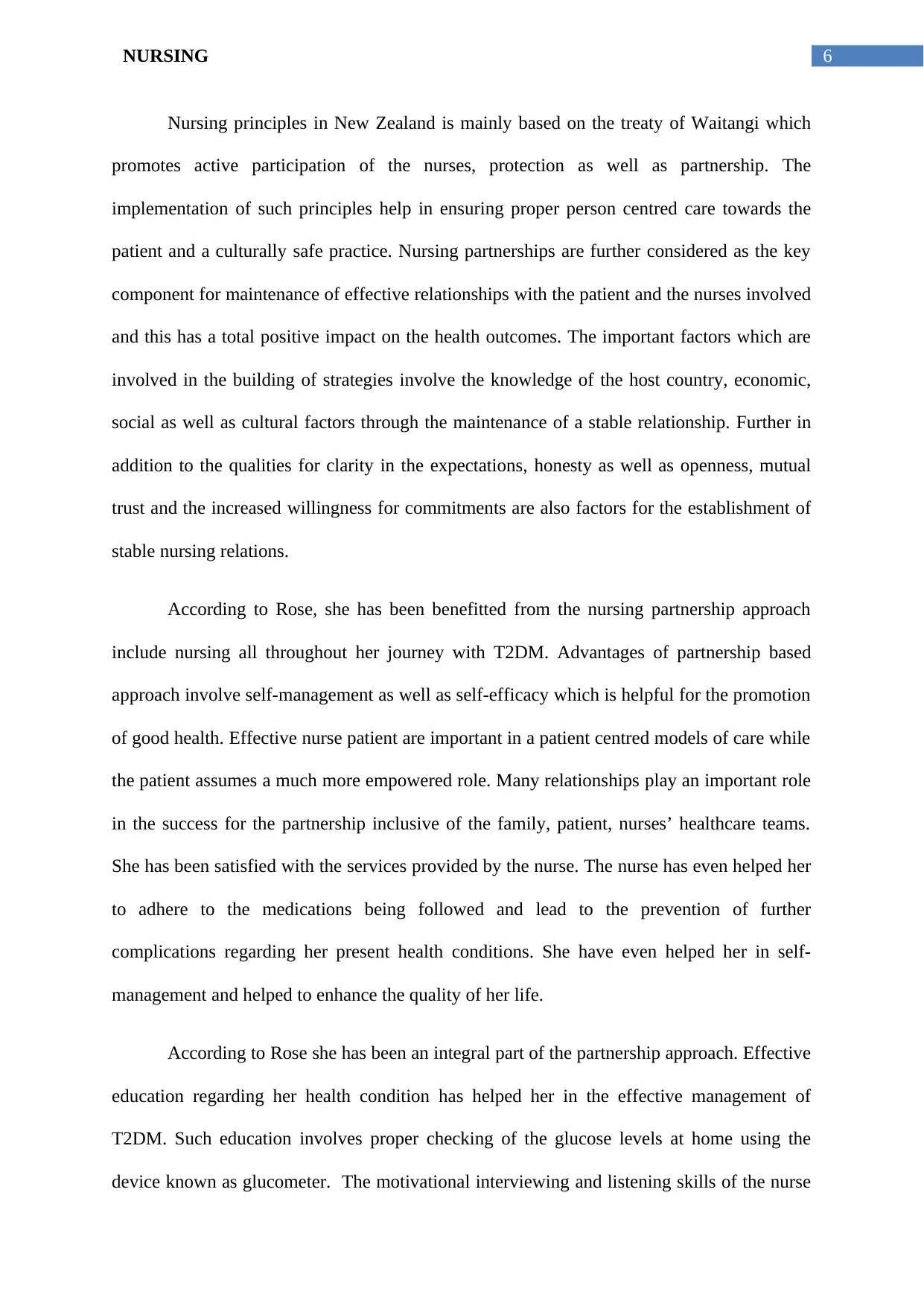
6NURSING
Nursing principles in New Zealand is mainly based on the treaty of Waitangi which
promotes active participation of the nurses, protection as well as partnership. The
implementation of such principles help in ensuring proper person centred care towards the
patient and a culturally safe practice. Nursing partnerships are further considered as the key
component for maintenance of effective relationships with the patient and the nurses involved
and this has a total positive impact on the health outcomes. The important factors which are
involved in the building of strategies involve the knowledge of the host country, economic,
social as well as cultural factors through the maintenance of a stable relationship. Further in
addition to the qualities for clarity in the expectations, honesty as well as openness, mutual
trust and the increased willingness for commitments are also factors for the establishment of
stable nursing relations.
According to Rose, she has been benefitted from the nursing partnership approach
include nursing all throughout her journey with T2DM. Advantages of partnership based
approach involve self-management as well as self-efficacy which is helpful for the promotion
of good health. Effective nurse patient are important in a patient centred models of care while
the patient assumes a much more empowered role. Many relationships play an important role
in the success for the partnership inclusive of the family, patient, nurses’ healthcare teams.
She has been satisfied with the services provided by the nurse. The nurse has even helped her
to adhere to the medications being followed and lead to the prevention of further
complications regarding her present health conditions. She have even helped her in self-
management and helped to enhance the quality of her life.
According to Rose she has been an integral part of the partnership approach. Effective
education regarding her health condition has helped her in the effective management of
T2DM. Such education involves proper checking of the glucose levels at home using the
device known as glucometer. The motivational interviewing and listening skills of the nurse
Nursing principles in New Zealand is mainly based on the treaty of Waitangi which
promotes active participation of the nurses, protection as well as partnership. The
implementation of such principles help in ensuring proper person centred care towards the
patient and a culturally safe practice. Nursing partnerships are further considered as the key
component for maintenance of effective relationships with the patient and the nurses involved
and this has a total positive impact on the health outcomes. The important factors which are
involved in the building of strategies involve the knowledge of the host country, economic,
social as well as cultural factors through the maintenance of a stable relationship. Further in
addition to the qualities for clarity in the expectations, honesty as well as openness, mutual
trust and the increased willingness for commitments are also factors for the establishment of
stable nursing relations.
According to Rose, she has been benefitted from the nursing partnership approach
include nursing all throughout her journey with T2DM. Advantages of partnership based
approach involve self-management as well as self-efficacy which is helpful for the promotion
of good health. Effective nurse patient are important in a patient centred models of care while
the patient assumes a much more empowered role. Many relationships play an important role
in the success for the partnership inclusive of the family, patient, nurses’ healthcare teams.
She has been satisfied with the services provided by the nurse. The nurse has even helped her
to adhere to the medications being followed and lead to the prevention of further
complications regarding her present health conditions. She have even helped her in self-
management and helped to enhance the quality of her life.
According to Rose she has been an integral part of the partnership approach. Effective
education regarding her health condition has helped her in the effective management of
T2DM. Such education involves proper checking of the glucose levels at home using the
device known as glucometer. The motivational interviewing and listening skills of the nurse
Paraphrase This Document
Need a fresh take? Get an instant paraphrase of this document with our AI Paraphraser

7NURSING
have been satisfying as Mrs Rose have been benefitted through the interaction. According to
Murdaugh, Parsons& Pender (2018), contemporary method of nursing like e-learning have
been by far the most significant change occurs in nursing education which have enhanced the
education system leading to effective education. According to Mrs Rose, successful
therapeutic relationships have been established among the nurse and herself. She have not
received any kind of pain and her health condition have improved much well than before
through effective interactions with the nurse.
The major health issues which Mrs Rose have experienced in excessive fatigue due to
hyperglycaemia alongside the odour due to her ulcers and pain due to the ulcers. For
addressing this issue, the proper development of self-assessment as well as self-care
management is required. For proper understanding of the self-assessment skills the nurse
follows a person centred approach primarily focussing on the patient. The nurse should listen
inventively to the requirements of the patient as listening skills are of utmost importance in
person centred care as well as partnership approach. Depending on the condition of ulcers on
Mrs Rose’s foot a proper wound care pathway should be incorporated. The nurse can also
strictly monitor the doses of her medications for effective pain management. Moreover, the
use of analgesics can be introduced for effective reduction of the pain due to the development
of ulcers. Following the practice of sterile technique as well as adequate would materials
would be used for the assessment of wounds which could help her in healing the wounds and
help in the reduction of pain.
For management of the mal odour, the dressing in her wounds can be changed
frequently which can be the best possible way of treatment for the nurse. Apart from these
two main health problems she have also suffered from frequent urination, disturbed sleep,
restless leg syndrome and obesity. For assessment of the disturbances in sleep, the nurse
should intro intervention for effectively controlling the sleeping patterns.
have been satisfying as Mrs Rose have been benefitted through the interaction. According to
Murdaugh, Parsons& Pender (2018), contemporary method of nursing like e-learning have
been by far the most significant change occurs in nursing education which have enhanced the
education system leading to effective education. According to Mrs Rose, successful
therapeutic relationships have been established among the nurse and herself. She have not
received any kind of pain and her health condition have improved much well than before
through effective interactions with the nurse.
The major health issues which Mrs Rose have experienced in excessive fatigue due to
hyperglycaemia alongside the odour due to her ulcers and pain due to the ulcers. For
addressing this issue, the proper development of self-assessment as well as self-care
management is required. For proper understanding of the self-assessment skills the nurse
follows a person centred approach primarily focussing on the patient. The nurse should listen
inventively to the requirements of the patient as listening skills are of utmost importance in
person centred care as well as partnership approach. Depending on the condition of ulcers on
Mrs Rose’s foot a proper wound care pathway should be incorporated. The nurse can also
strictly monitor the doses of her medications for effective pain management. Moreover, the
use of analgesics can be introduced for effective reduction of the pain due to the development
of ulcers. Following the practice of sterile technique as well as adequate would materials
would be used for the assessment of wounds which could help her in healing the wounds and
help in the reduction of pain.
For management of the mal odour, the dressing in her wounds can be changed
frequently which can be the best possible way of treatment for the nurse. Apart from these
two main health problems she have also suffered from frequent urination, disturbed sleep,
restless leg syndrome and obesity. For assessment of the disturbances in sleep, the nurse
should intro intervention for effectively controlling the sleeping patterns.
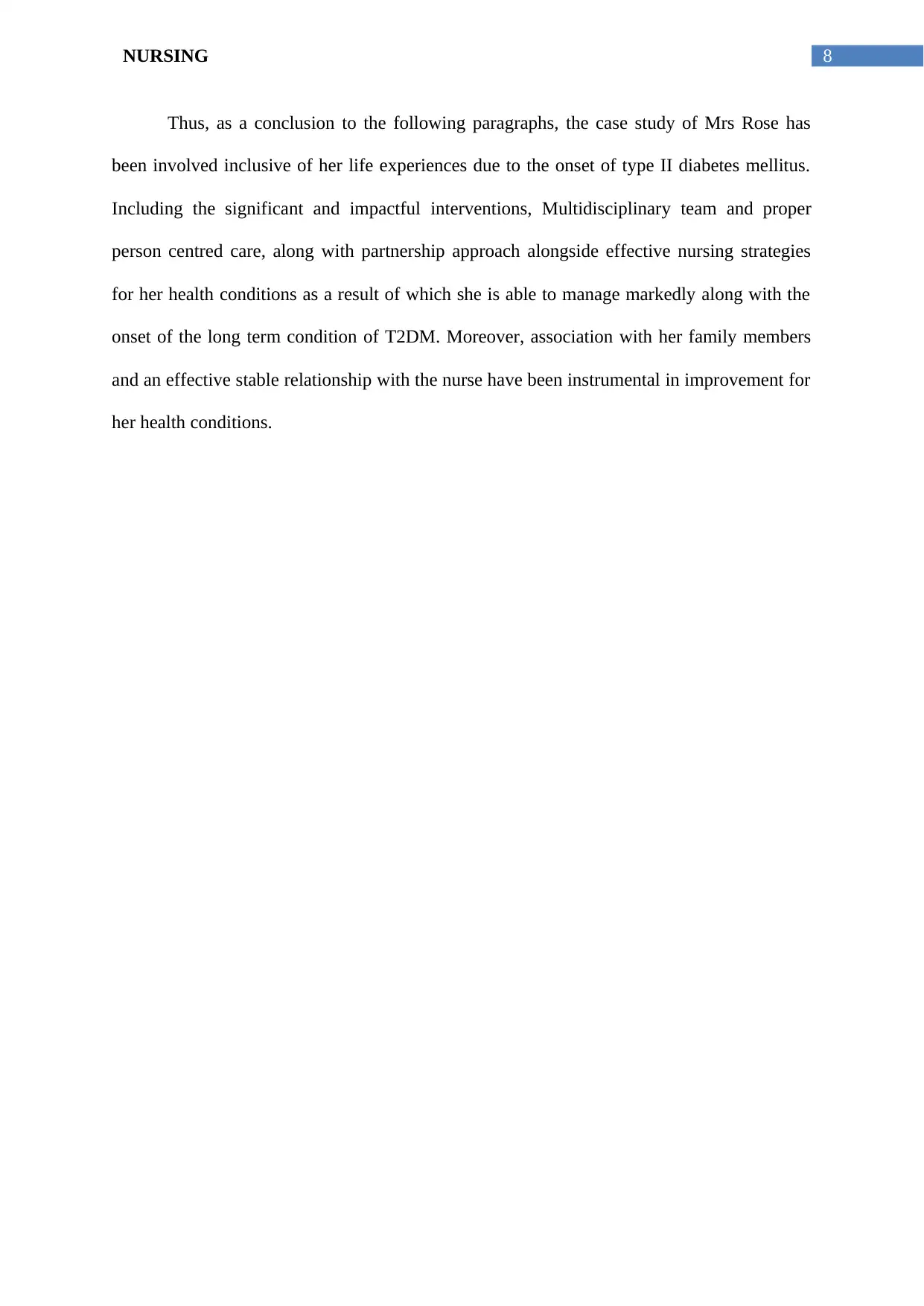
8NURSING
Thus, as a conclusion to the following paragraphs, the case study of Mrs Rose has
been involved inclusive of her life experiences due to the onset of type II diabetes mellitus.
Including the significant and impactful interventions, Multidisciplinary team and proper
person centred care, along with partnership approach alongside effective nursing strategies
for her health conditions as a result of which she is able to manage markedly along with the
onset of the long term condition of T2DM. Moreover, association with her family members
and an effective stable relationship with the nurse have been instrumental in improvement for
her health conditions.
Thus, as a conclusion to the following paragraphs, the case study of Mrs Rose has
been involved inclusive of her life experiences due to the onset of type II diabetes mellitus.
Including the significant and impactful interventions, Multidisciplinary team and proper
person centred care, along with partnership approach alongside effective nursing strategies
for her health conditions as a result of which she is able to manage markedly along with the
onset of the long term condition of T2DM. Moreover, association with her family members
and an effective stable relationship with the nurse have been instrumental in improvement for
her health conditions.
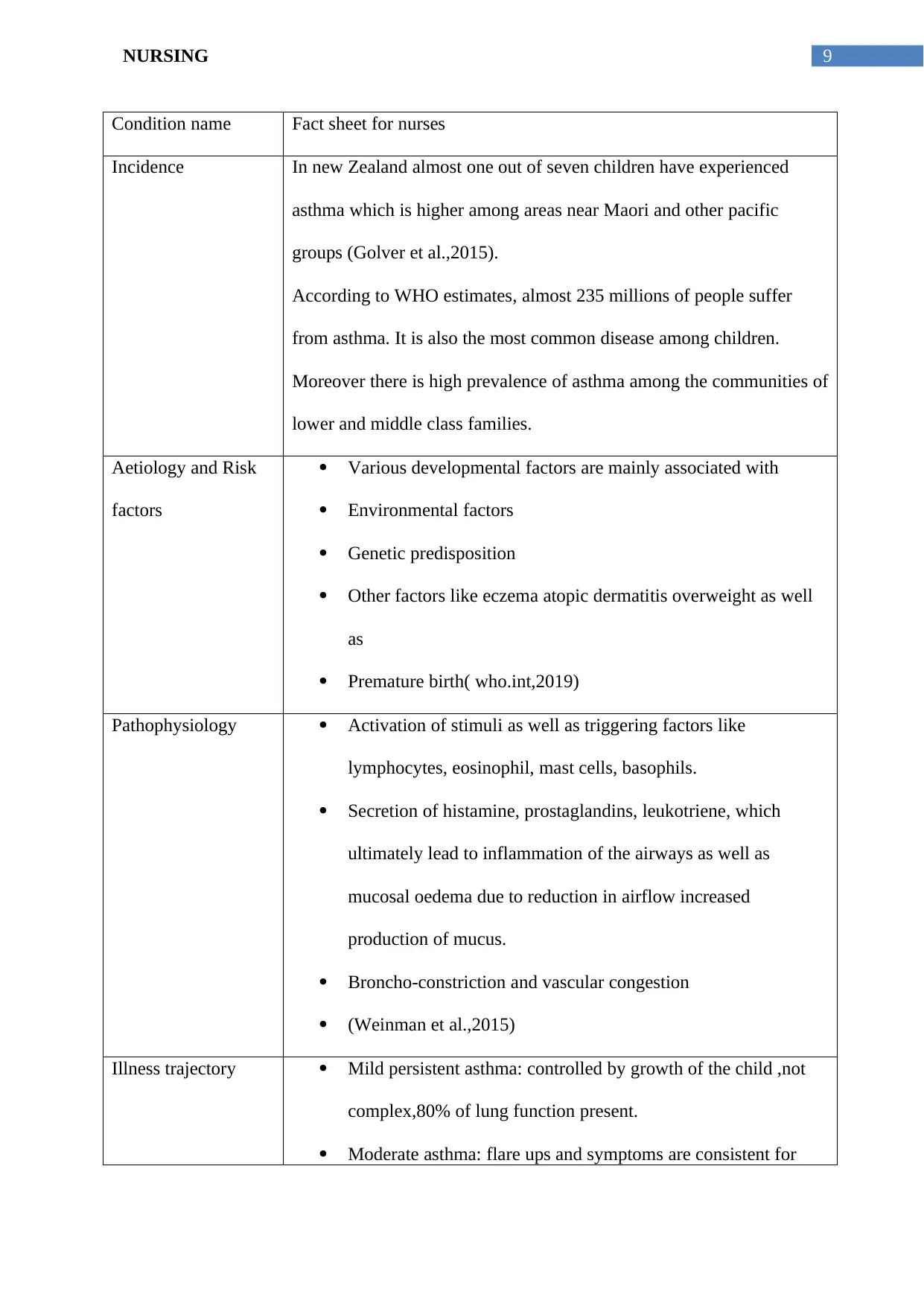
9NURSING
Condition name Fact sheet for nurses
Incidence In new Zealand almost one out of seven children have experienced
asthma which is higher among areas near Maori and other pacific
groups (Golver et al.,2015).
According to WHO estimates, almost 235 millions of people suffer
from asthma. It is also the most common disease among children.
Moreover there is high prevalence of asthma among the communities of
lower and middle class families.
Aetiology and Risk
factors
Various developmental factors are mainly associated with
Environmental factors
Genetic predisposition
Other factors like eczema atopic dermatitis overweight as well
as
Premature birth( who.int,2019)
Pathophysiology Activation of stimuli as well as triggering factors like
lymphocytes, eosinophil, mast cells, basophils.
Secretion of histamine, prostaglandins, leukotriene, which
ultimately lead to inflammation of the airways as well as
mucosal oedema due to reduction in airflow increased
production of mucus.
Broncho-constriction and vascular congestion
(Weinman et al.,2015)
Illness trajectory Mild persistent asthma: controlled by growth of the child ,not
complex,80% of lung function present.
Moderate asthma: flare ups and symptoms are consistent for
Condition name Fact sheet for nurses
Incidence In new Zealand almost one out of seven children have experienced
asthma which is higher among areas near Maori and other pacific
groups (Golver et al.,2015).
According to WHO estimates, almost 235 millions of people suffer
from asthma. It is also the most common disease among children.
Moreover there is high prevalence of asthma among the communities of
lower and middle class families.
Aetiology and Risk
factors
Various developmental factors are mainly associated with
Environmental factors
Genetic predisposition
Other factors like eczema atopic dermatitis overweight as well
as
Premature birth( who.int,2019)
Pathophysiology Activation of stimuli as well as triggering factors like
lymphocytes, eosinophil, mast cells, basophils.
Secretion of histamine, prostaglandins, leukotriene, which
ultimately lead to inflammation of the airways as well as
mucosal oedema due to reduction in airflow increased
production of mucus.
Broncho-constriction and vascular congestion
(Weinman et al.,2015)
Illness trajectory Mild persistent asthma: controlled by growth of the child ,not
complex,80% of lung function present.
Moderate asthma: flare ups and symptoms are consistent for
Secure Best Marks with AI Grader
Need help grading? Try our AI Grader for instant feedback on your assignments.
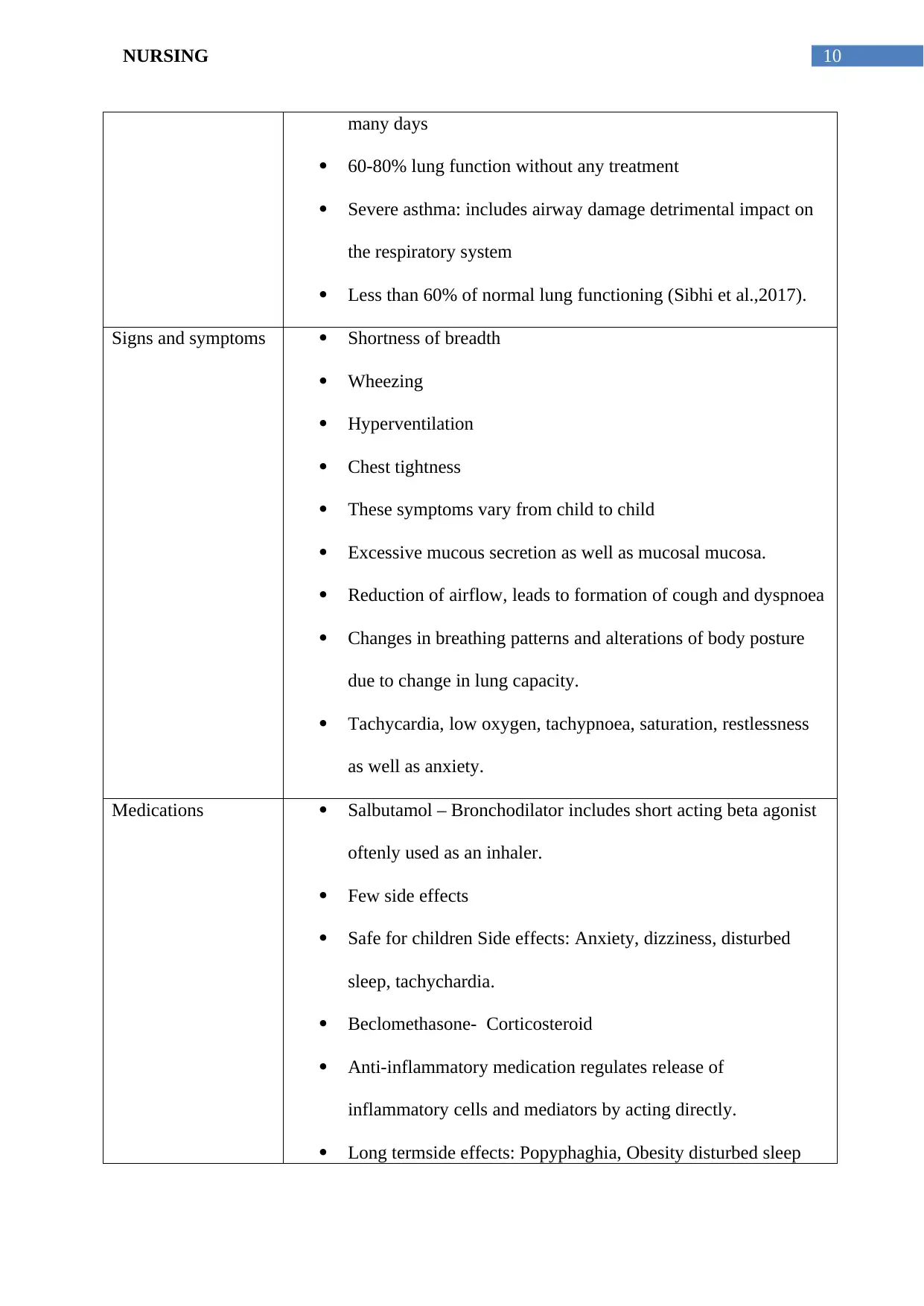
10NURSING
many days
60-80% lung function without any treatment
Severe asthma: includes airway damage detrimental impact on
the respiratory system
Less than 60% of normal lung functioning (Sibhi et al.,2017).
Signs and symptoms Shortness of breadth
Wheezing
Hyperventilation
Chest tightness
These symptoms vary from child to child
Excessive mucous secretion as well as mucosal mucosa.
Reduction of airflow, leads to formation of cough and dyspnoea
Changes in breathing patterns and alterations of body posture
due to change in lung capacity.
Tachycardia, low oxygen, tachypnoea, saturation, restlessness
as well as anxiety.
Medications Salbutamol – Bronchodilator includes short acting beta agonist
oftenly used as an inhaler.
Few side effects
Safe for children Side effects: Anxiety, dizziness, disturbed
sleep, tachychardia.
Beclomethasone- Corticosteroid
Anti-inflammatory medication regulates release of
inflammatory cells and mediators by acting directly.
Long termside effects: Popyphaghia, Obesity disturbed sleep
many days
60-80% lung function without any treatment
Severe asthma: includes airway damage detrimental impact on
the respiratory system
Less than 60% of normal lung functioning (Sibhi et al.,2017).
Signs and symptoms Shortness of breadth
Wheezing
Hyperventilation
Chest tightness
These symptoms vary from child to child
Excessive mucous secretion as well as mucosal mucosa.
Reduction of airflow, leads to formation of cough and dyspnoea
Changes in breathing patterns and alterations of body posture
due to change in lung capacity.
Tachycardia, low oxygen, tachypnoea, saturation, restlessness
as well as anxiety.
Medications Salbutamol – Bronchodilator includes short acting beta agonist
oftenly used as an inhaler.
Few side effects
Safe for children Side effects: Anxiety, dizziness, disturbed
sleep, tachychardia.
Beclomethasone- Corticosteroid
Anti-inflammatory medication regulates release of
inflammatory cells and mediators by acting directly.
Long termside effects: Popyphaghia, Obesity disturbed sleep
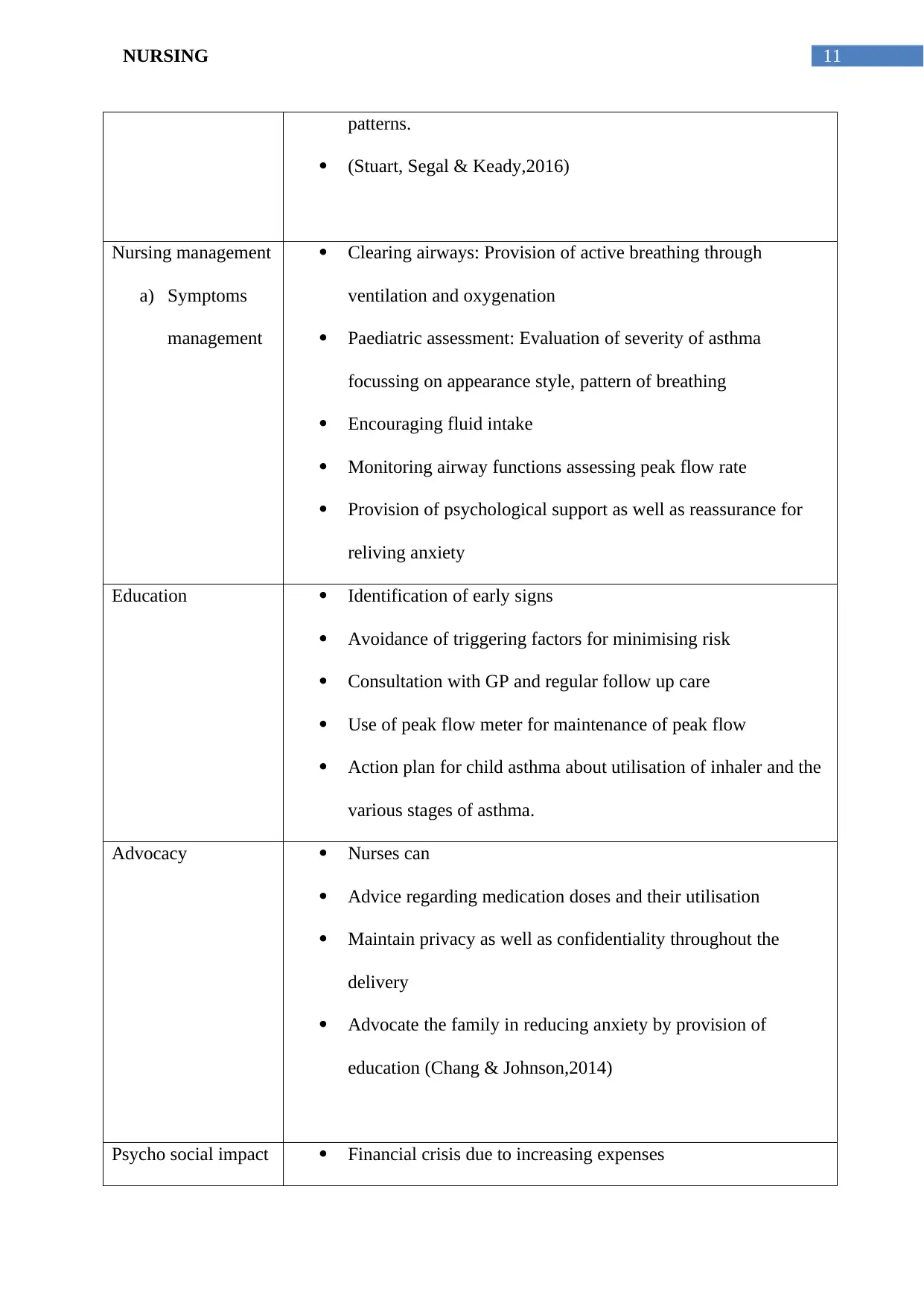
11NURSING
patterns.
(Stuart, Segal & Keady,2016)
Nursing management
a) Symptoms
management
Clearing airways: Provision of active breathing through
ventilation and oxygenation
Paediatric assessment: Evaluation of severity of asthma
focussing on appearance style, pattern of breathing
Encouraging fluid intake
Monitoring airway functions assessing peak flow rate
Provision of psychological support as well as reassurance for
reliving anxiety
Education Identification of early signs
Avoidance of triggering factors for minimising risk
Consultation with GP and regular follow up care
Use of peak flow meter for maintenance of peak flow
Action plan for child asthma about utilisation of inhaler and the
various stages of asthma.
Advocacy Nurses can
Advice regarding medication doses and their utilisation
Maintain privacy as well as confidentiality throughout the
delivery
Advocate the family in reducing anxiety by provision of
education (Chang & Johnson,2014)
Psycho social impact Financial crisis due to increasing expenses
patterns.
(Stuart, Segal & Keady,2016)
Nursing management
a) Symptoms
management
Clearing airways: Provision of active breathing through
ventilation and oxygenation
Paediatric assessment: Evaluation of severity of asthma
focussing on appearance style, pattern of breathing
Encouraging fluid intake
Monitoring airway functions assessing peak flow rate
Provision of psychological support as well as reassurance for
reliving anxiety
Education Identification of early signs
Avoidance of triggering factors for minimising risk
Consultation with GP and regular follow up care
Use of peak flow meter for maintenance of peak flow
Action plan for child asthma about utilisation of inhaler and the
various stages of asthma.
Advocacy Nurses can
Advice regarding medication doses and their utilisation
Maintain privacy as well as confidentiality throughout the
delivery
Advocate the family in reducing anxiety by provision of
education (Chang & Johnson,2014)
Psycho social impact Financial crisis due to increasing expenses
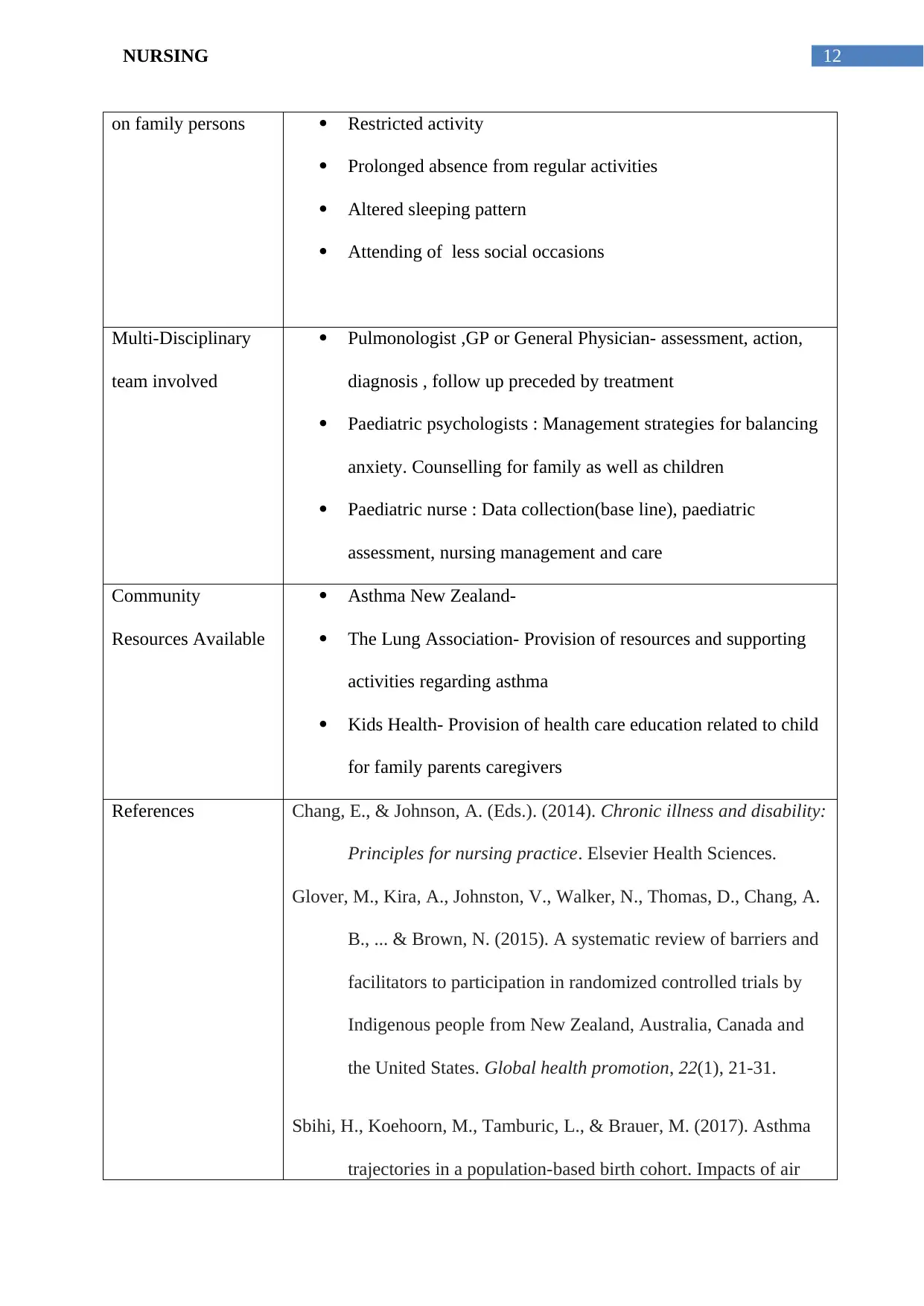
12NURSING
on family persons Restricted activity
Prolonged absence from regular activities
Altered sleeping pattern
Attending of less social occasions
Multi-Disciplinary
team involved
Pulmonologist ,GP or General Physician- assessment, action,
diagnosis , follow up preceded by treatment
Paediatric psychologists : Management strategies for balancing
anxiety. Counselling for family as well as children
Paediatric nurse : Data collection(base line), paediatric
assessment, nursing management and care
Community
Resources Available
Asthma New Zealand-
The Lung Association- Provision of resources and supporting
activities regarding asthma
Kids Health- Provision of health care education related to child
for family parents caregivers
References Chang, E., & Johnson, A. (Eds.). (2014). Chronic illness and disability:
Principles for nursing practice. Elsevier Health Sciences.
Glover, M., Kira, A., Johnston, V., Walker, N., Thomas, D., Chang, A.
B., ... & Brown, N. (2015). A systematic review of barriers and
facilitators to participation in randomized controlled trials by
Indigenous people from New Zealand, Australia, Canada and
the United States. Global health promotion, 22(1), 21-31.
Sbihi, H., Koehoorn, M., Tamburic, L., & Brauer, M. (2017). Asthma
trajectories in a population-based birth cohort. Impacts of air
on family persons Restricted activity
Prolonged absence from regular activities
Altered sleeping pattern
Attending of less social occasions
Multi-Disciplinary
team involved
Pulmonologist ,GP or General Physician- assessment, action,
diagnosis , follow up preceded by treatment
Paediatric psychologists : Management strategies for balancing
anxiety. Counselling for family as well as children
Paediatric nurse : Data collection(base line), paediatric
assessment, nursing management and care
Community
Resources Available
Asthma New Zealand-
The Lung Association- Provision of resources and supporting
activities regarding asthma
Kids Health- Provision of health care education related to child
for family parents caregivers
References Chang, E., & Johnson, A. (Eds.). (2014). Chronic illness and disability:
Principles for nursing practice. Elsevier Health Sciences.
Glover, M., Kira, A., Johnston, V., Walker, N., Thomas, D., Chang, A.
B., ... & Brown, N. (2015). A systematic review of barriers and
facilitators to participation in randomized controlled trials by
Indigenous people from New Zealand, Australia, Canada and
the United States. Global health promotion, 22(1), 21-31.
Sbihi, H., Koehoorn, M., Tamburic, L., & Brauer, M. (2017). Asthma
trajectories in a population-based birth cohort. Impacts of air
Paraphrase This Document
Need a fresh take? Get an instant paraphrase of this document with our AI Paraphraser
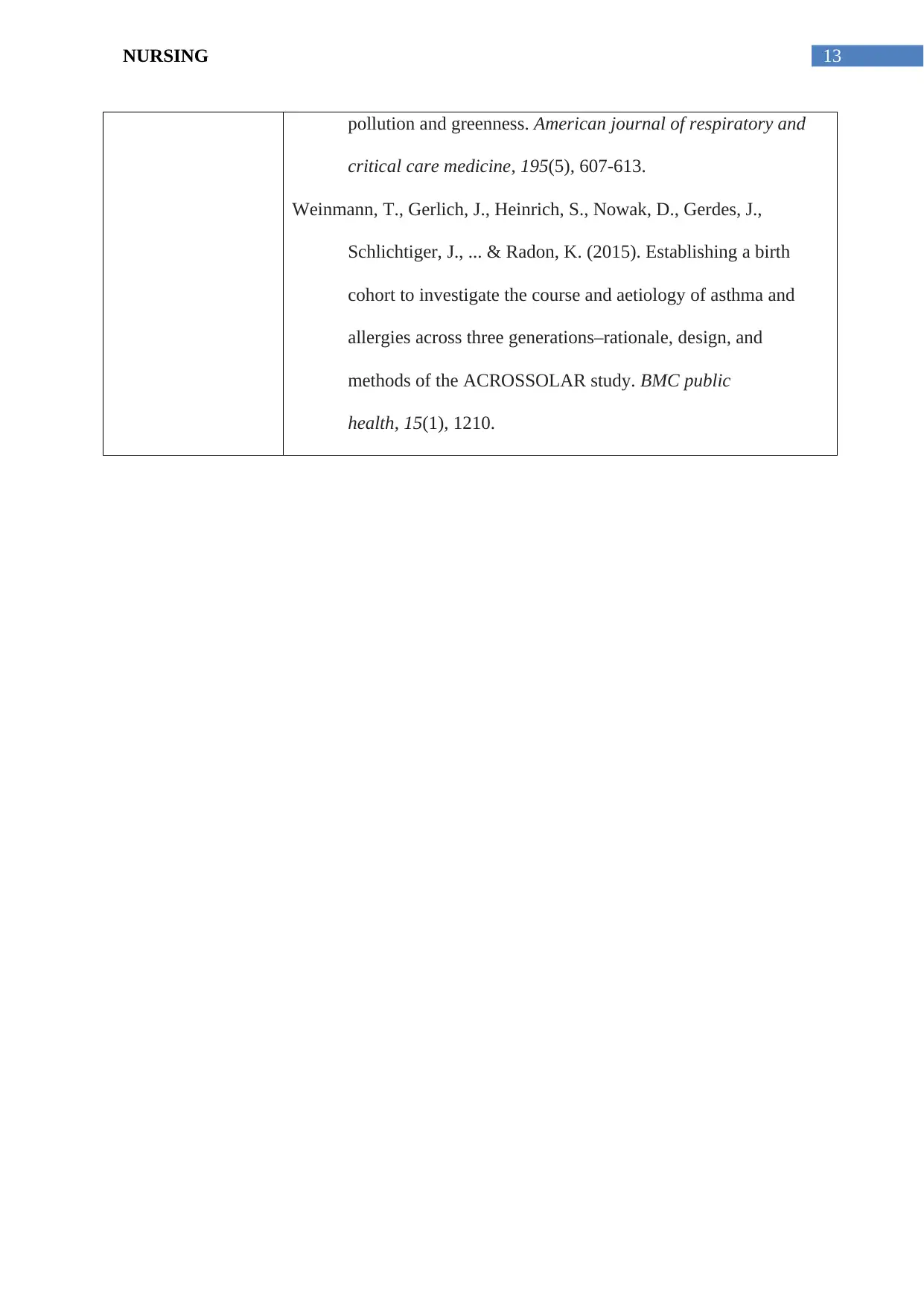
13NURSING
pollution and greenness. American journal of respiratory and
critical care medicine, 195(5), 607-613.
Weinmann, T., Gerlich, J., Heinrich, S., Nowak, D., Gerdes, J.,
Schlichtiger, J., ... & Radon, K. (2015). Establishing a birth
cohort to investigate the course and aetiology of asthma and
allergies across three generations–rationale, design, and
methods of the ACROSSOLAR study. BMC public
health, 15(1), 1210.
pollution and greenness. American journal of respiratory and
critical care medicine, 195(5), 607-613.
Weinmann, T., Gerlich, J., Heinrich, S., Nowak, D., Gerdes, J.,
Schlichtiger, J., ... & Radon, K. (2015). Establishing a birth
cohort to investigate the course and aetiology of asthma and
allergies across three generations–rationale, design, and
methods of the ACROSSOLAR study. BMC public
health, 15(1), 1210.
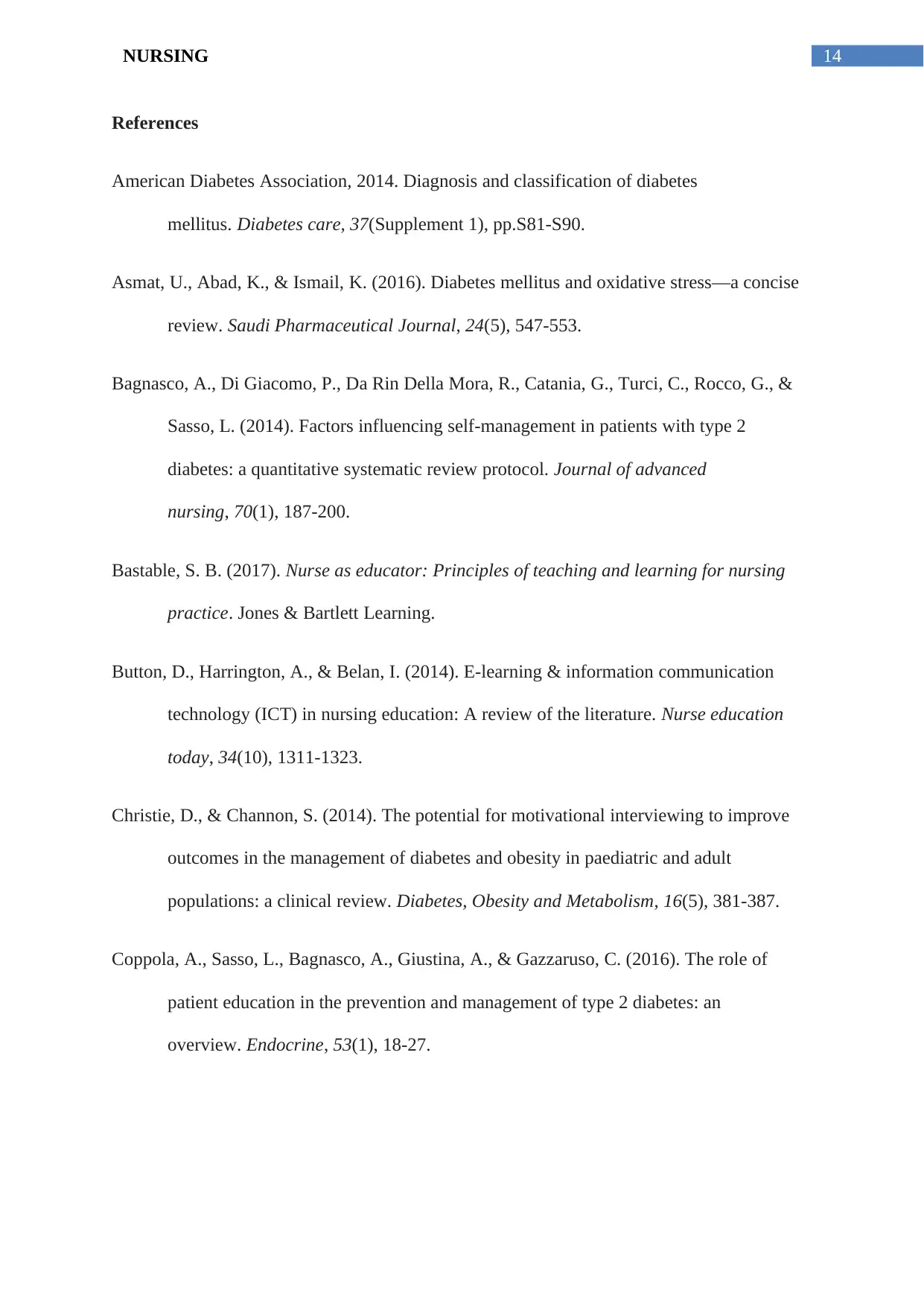
14NURSING
References
American Diabetes Association, 2014. Diagnosis and classification of diabetes
mellitus. Diabetes care, 37(Supplement 1), pp.S81-S90.
Asmat, U., Abad, K., & Ismail, K. (2016). Diabetes mellitus and oxidative stress—a concise
review. Saudi Pharmaceutical Journal, 24(5), 547-553.
Bagnasco, A., Di Giacomo, P., Da Rin Della Mora, R., Catania, G., Turci, C., Rocco, G., &
Sasso, L. (2014). Factors influencing self‐management in patients with type 2
diabetes: a quantitative systematic review protocol. Journal of advanced
nursing, 70(1), 187-200.
Bastable, S. B. (2017). Nurse as educator: Principles of teaching and learning for nursing
practice. Jones & Bartlett Learning.
Button, D., Harrington, A., & Belan, I. (2014). E-learning & information communication
technology (ICT) in nursing education: A review of the literature. Nurse education
today, 34(10), 1311-1323.
Christie, D., & Channon, S. (2014). The potential for motivational interviewing to improve
outcomes in the management of diabetes and obesity in paediatric and adult
populations: a clinical review. Diabetes, Obesity and Metabolism, 16(5), 381-387.
Coppola, A., Sasso, L., Bagnasco, A., Giustina, A., & Gazzaruso, C. (2016). The role of
patient education in the prevention and management of type 2 diabetes: an
overview. Endocrine, 53(1), 18-27.
References
American Diabetes Association, 2014. Diagnosis and classification of diabetes
mellitus. Diabetes care, 37(Supplement 1), pp.S81-S90.
Asmat, U., Abad, K., & Ismail, K. (2016). Diabetes mellitus and oxidative stress—a concise
review. Saudi Pharmaceutical Journal, 24(5), 547-553.
Bagnasco, A., Di Giacomo, P., Da Rin Della Mora, R., Catania, G., Turci, C., Rocco, G., &
Sasso, L. (2014). Factors influencing self‐management in patients with type 2
diabetes: a quantitative systematic review protocol. Journal of advanced
nursing, 70(1), 187-200.
Bastable, S. B. (2017). Nurse as educator: Principles of teaching and learning for nursing
practice. Jones & Bartlett Learning.
Button, D., Harrington, A., & Belan, I. (2014). E-learning & information communication
technology (ICT) in nursing education: A review of the literature. Nurse education
today, 34(10), 1311-1323.
Christie, D., & Channon, S. (2014). The potential for motivational interviewing to improve
outcomes in the management of diabetes and obesity in paediatric and adult
populations: a clinical review. Diabetes, Obesity and Metabolism, 16(5), 381-387.
Coppola, A., Sasso, L., Bagnasco, A., Giustina, A., & Gazzaruso, C. (2016). The role of
patient education in the prevention and management of type 2 diabetes: an
overview. Endocrine, 53(1), 18-27.
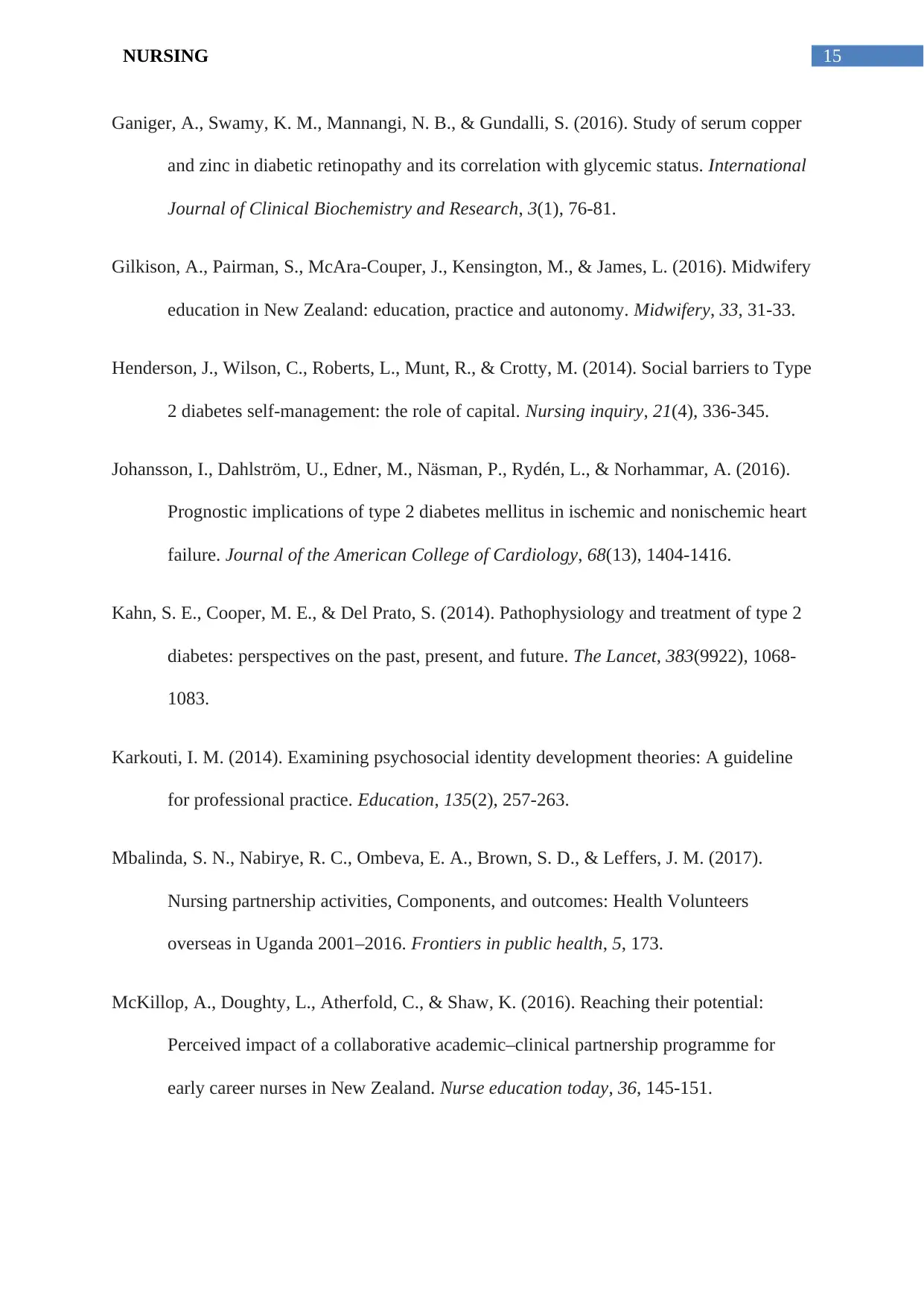
15NURSING
Ganiger, A., Swamy, K. M., Mannangi, N. B., & Gundalli, S. (2016). Study of serum copper
and zinc in diabetic retinopathy and its correlation with glycemic status. International
Journal of Clinical Biochemistry and Research, 3(1), 76-81.
Gilkison, A., Pairman, S., McAra-Couper, J., Kensington, M., & James, L. (2016). Midwifery
education in New Zealand: education, practice and autonomy. Midwifery, 33, 31-33.
Henderson, J., Wilson, C., Roberts, L., Munt, R., & Crotty, M. (2014). Social barriers to Type
2 diabetes self‐management: the role of capital. Nursing inquiry, 21(4), 336-345.
Johansson, I., Dahlström, U., Edner, M., Näsman, P., Rydén, L., & Norhammar, A. (2016).
Prognostic implications of type 2 diabetes mellitus in ischemic and nonischemic heart
failure. Journal of the American College of Cardiology, 68(13), 1404-1416.
Kahn, S. E., Cooper, M. E., & Del Prato, S. (2014). Pathophysiology and treatment of type 2
diabetes: perspectives on the past, present, and future. The Lancet, 383(9922), 1068-
1083.
Karkouti, I. M. (2014). Examining psychosocial identity development theories: A guideline
for professional practice. Education, 135(2), 257-263.
Mbalinda, S. N., Nabirye, R. C., Ombeva, E. A., Brown, S. D., & Leffers, J. M. (2017).
Nursing partnership activities, Components, and outcomes: Health Volunteers
overseas in Uganda 2001–2016. Frontiers in public health, 5, 173.
McKillop, A., Doughty, L., Atherfold, C., & Shaw, K. (2016). Reaching their potential:
Perceived impact of a collaborative academic–clinical partnership programme for
early career nurses in New Zealand. Nurse education today, 36, 145-151.
Ganiger, A., Swamy, K. M., Mannangi, N. B., & Gundalli, S. (2016). Study of serum copper
and zinc in diabetic retinopathy and its correlation with glycemic status. International
Journal of Clinical Biochemistry and Research, 3(1), 76-81.
Gilkison, A., Pairman, S., McAra-Couper, J., Kensington, M., & James, L. (2016). Midwifery
education in New Zealand: education, practice and autonomy. Midwifery, 33, 31-33.
Henderson, J., Wilson, C., Roberts, L., Munt, R., & Crotty, M. (2014). Social barriers to Type
2 diabetes self‐management: the role of capital. Nursing inquiry, 21(4), 336-345.
Johansson, I., Dahlström, U., Edner, M., Näsman, P., Rydén, L., & Norhammar, A. (2016).
Prognostic implications of type 2 diabetes mellitus in ischemic and nonischemic heart
failure. Journal of the American College of Cardiology, 68(13), 1404-1416.
Kahn, S. E., Cooper, M. E., & Del Prato, S. (2014). Pathophysiology and treatment of type 2
diabetes: perspectives on the past, present, and future. The Lancet, 383(9922), 1068-
1083.
Karkouti, I. M. (2014). Examining psychosocial identity development theories: A guideline
for professional practice. Education, 135(2), 257-263.
Mbalinda, S. N., Nabirye, R. C., Ombeva, E. A., Brown, S. D., & Leffers, J. M. (2017).
Nursing partnership activities, Components, and outcomes: Health Volunteers
overseas in Uganda 2001–2016. Frontiers in public health, 5, 173.
McKillop, A., Doughty, L., Atherfold, C., & Shaw, K. (2016). Reaching their potential:
Perceived impact of a collaborative academic–clinical partnership programme for
early career nurses in New Zealand. Nurse education today, 36, 145-151.
Secure Best Marks with AI Grader
Need help grading? Try our AI Grader for instant feedback on your assignments.
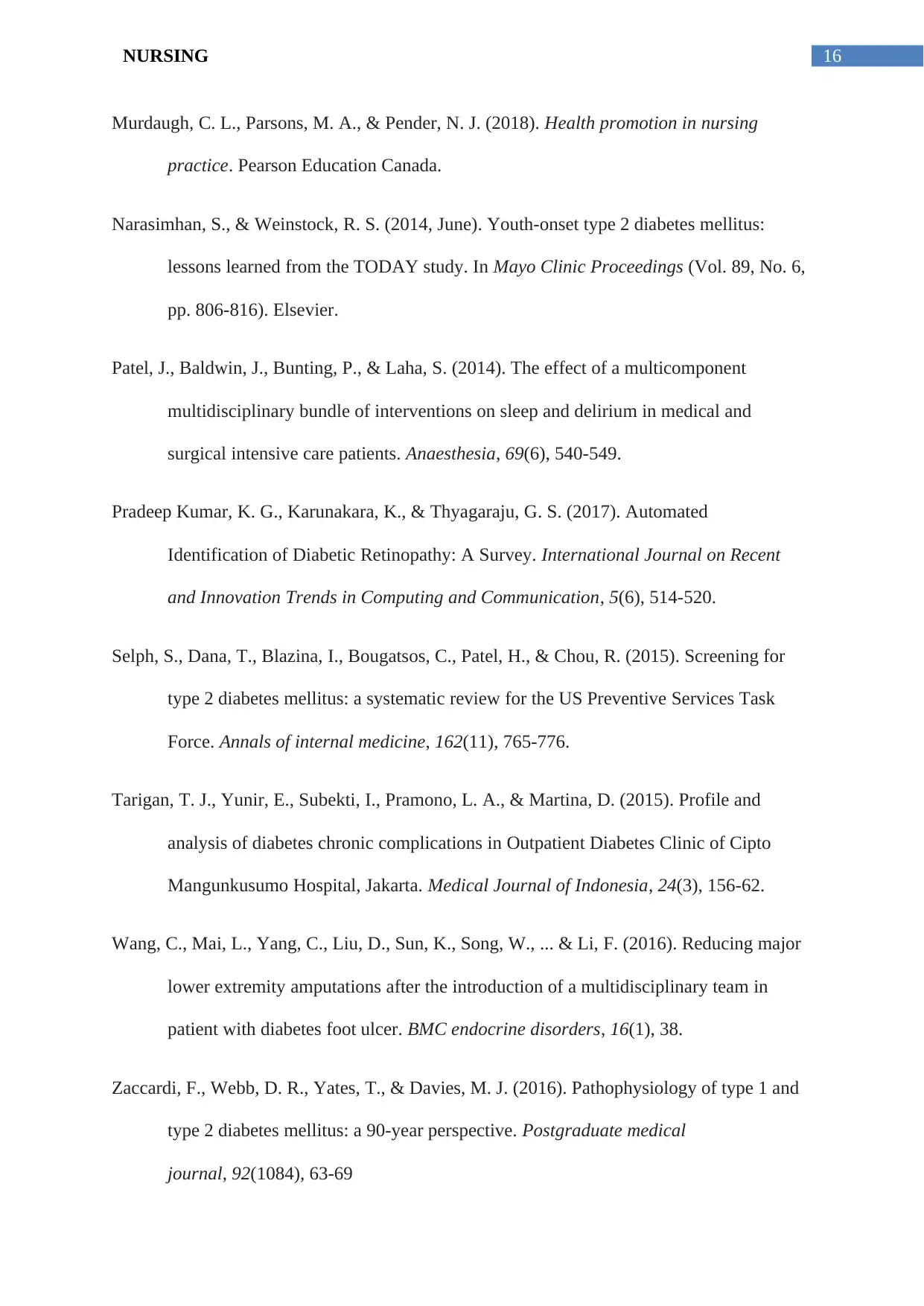
16NURSING
Murdaugh, C. L., Parsons, M. A., & Pender, N. J. (2018). Health promotion in nursing
practice. Pearson Education Canada.
Narasimhan, S., & Weinstock, R. S. (2014, June). Youth-onset type 2 diabetes mellitus:
lessons learned from the TODAY study. In Mayo Clinic Proceedings (Vol. 89, No. 6,
pp. 806-816). Elsevier.
Patel, J., Baldwin, J., Bunting, P., & Laha, S. (2014). The effect of a multicomponent
multidisciplinary bundle of interventions on sleep and delirium in medical and
surgical intensive care patients. Anaesthesia, 69(6), 540-549.
Pradeep Kumar, K. G., Karunakara, K., & Thyagaraju, G. S. (2017). Automated
Identification of Diabetic Retinopathy: A Survey. International Journal on Recent
and Innovation Trends in Computing and Communication, 5(6), 514-520.
Selph, S., Dana, T., Blazina, I., Bougatsos, C., Patel, H., & Chou, R. (2015). Screening for
type 2 diabetes mellitus: a systematic review for the US Preventive Services Task
Force. Annals of internal medicine, 162(11), 765-776.
Tarigan, T. J., Yunir, E., Subekti, I., Pramono, L. A., & Martina, D. (2015). Profile and
analysis of diabetes chronic complications in Outpatient Diabetes Clinic of Cipto
Mangunkusumo Hospital, Jakarta. Medical Journal of Indonesia, 24(3), 156-62.
Wang, C., Mai, L., Yang, C., Liu, D., Sun, K., Song, W., ... & Li, F. (2016). Reducing major
lower extremity amputations after the introduction of a multidisciplinary team in
patient with diabetes foot ulcer. BMC endocrine disorders, 16(1), 38.
Zaccardi, F., Webb, D. R., Yates, T., & Davies, M. J. (2016). Pathophysiology of type 1 and
type 2 diabetes mellitus: a 90-year perspective. Postgraduate medical
journal, 92(1084), 63-69
Murdaugh, C. L., Parsons, M. A., & Pender, N. J. (2018). Health promotion in nursing
practice. Pearson Education Canada.
Narasimhan, S., & Weinstock, R. S. (2014, June). Youth-onset type 2 diabetes mellitus:
lessons learned from the TODAY study. In Mayo Clinic Proceedings (Vol. 89, No. 6,
pp. 806-816). Elsevier.
Patel, J., Baldwin, J., Bunting, P., & Laha, S. (2014). The effect of a multicomponent
multidisciplinary bundle of interventions on sleep and delirium in medical and
surgical intensive care patients. Anaesthesia, 69(6), 540-549.
Pradeep Kumar, K. G., Karunakara, K., & Thyagaraju, G. S. (2017). Automated
Identification of Diabetic Retinopathy: A Survey. International Journal on Recent
and Innovation Trends in Computing and Communication, 5(6), 514-520.
Selph, S., Dana, T., Blazina, I., Bougatsos, C., Patel, H., & Chou, R. (2015). Screening for
type 2 diabetes mellitus: a systematic review for the US Preventive Services Task
Force. Annals of internal medicine, 162(11), 765-776.
Tarigan, T. J., Yunir, E., Subekti, I., Pramono, L. A., & Martina, D. (2015). Profile and
analysis of diabetes chronic complications in Outpatient Diabetes Clinic of Cipto
Mangunkusumo Hospital, Jakarta. Medical Journal of Indonesia, 24(3), 156-62.
Wang, C., Mai, L., Yang, C., Liu, D., Sun, K., Song, W., ... & Li, F. (2016). Reducing major
lower extremity amputations after the introduction of a multidisciplinary team in
patient with diabetes foot ulcer. BMC endocrine disorders, 16(1), 38.
Zaccardi, F., Webb, D. R., Yates, T., & Davies, M. J. (2016). Pathophysiology of type 1 and
type 2 diabetes mellitus: a 90-year perspective. Postgraduate medical
journal, 92(1084), 63-69
1 out of 17
Related Documents
Your All-in-One AI-Powered Toolkit for Academic Success.
+13062052269
info@desklib.com
Available 24*7 on WhatsApp / Email
![[object Object]](/_next/static/media/star-bottom.7253800d.svg)
Unlock your academic potential
© 2024 | Zucol Services PVT LTD | All rights reserved.




